Upper Rapeland Wood
Upper Rapeland Wood (sometimes Upper Rapelands Wood) is a mixed mature woodland in Old Holbrook, a hamlet close to Horsham, England. It lies on Rapeland Hill, on the north-western fringes of Old Holbrook, 1.2 miles (1.94 km) north of the A264 dual carriageway. It is directly opposite Northlands Copse, an area of ancient woodland and a partially managed plantation in the neighbouring hamlet of Graylands.[1]
| Upper Rapeland Wood | |
|---|---|
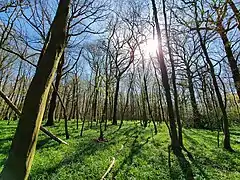 | |
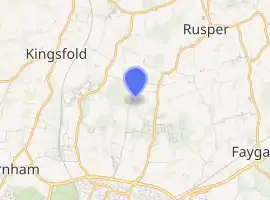
| |
| Type | Mixed woodland |
| Location | Old Holbrook, Horsham, England |
| OS grid | TQ188354 |
| Coordinates | 51°06′20.2″N 0°18′16.1″W |
| Area | 0.04 sq mi (0.11 km2) |
As the area lies on a steep hill, Upper Rapeland Wood has a relatively high elevation, being 350 feet above sea level. Broadleaf trees are prevalent in the moss-covered northern and southern areas of the woodland, with large pine trees and shallow ravines dominating the central areas. Notably, three channels of Northlands Gill flow through the width of Upper Rapeland Wood.[2]
The area hosts a network of tracks with varying degrees of accessibility. Although unmaintained, the tracks guide walkers in cardinal directions through the woodland.
Intensive prospecting for iron ore took place in the area in the 16th and 17th centuries. Geologists have noted the remains of an isolated minepit in Upper Rapeland Wood.[3] The wood lies at the centre of the Faygate Syncline, which runs between the Crawley Fault and the Holmbush Fault.[4] Most iron pits along the Faygate Syncline are on the Horsham Stone horizon, but the one in Rapeland Wood is anomalous in that it is on an outcrop of sandstone. A small stream has cut a deep valley through the wood and this may be responsible for exposing ironstone in a very localised area.[5]
The 1892–1914 25-inch Ordnance Survey map marks "Dismal Castle" on the northwestern border of the wood.[6] The building was actually a cottage occupied by the Hyde estate gamekeeper. It was demolished in 1987 and a new building now occupies the site.[7]
Gallery
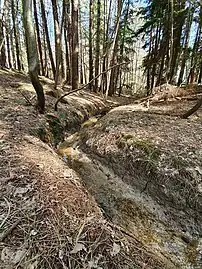 Pine trees and ravines dominate the central areas of the woodland
Pine trees and ravines dominate the central areas of the woodland Plants such as common primrose can be seen in these woods
Plants such as common primrose can be seen in these woods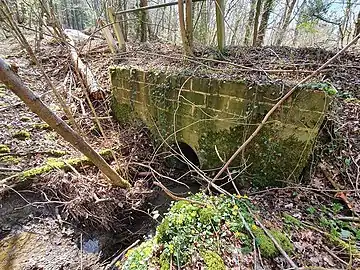 A bridge allows Northlands Gill to flow into Upper Rapeland Wood
A bridge allows Northlands Gill to flow into Upper Rapeland Wood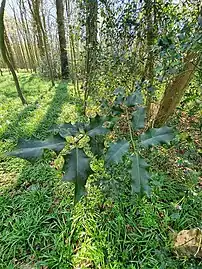 Holly leaves on a plant in the north of the woodland
Holly leaves on a plant in the north of the woodland
References
- "Upper Rapeland Wood, Horsham (RH12 4PP)". OS GetOutside. Retrieved 25 March 2020.
- "View: Surrey XLVII (includes: Slinfold; Warnham.) - Ordnance Survey Six-inch England and Wales, 1842-1952". maps.nls.uk. Retrieved 25 March 2020.
- Henry Cleere; David Crossley (1995). "The Iron Industry of Weald" (PDF). Merton Priory Press. p. 28. Retrieved 25 March 2020.
- Bernard Charles Worssam, A. A. Morter, The Stratigraphy of the Weald Clay, p. 8, HMSO, 1978 OCLC 5542184.
- Bernard Charles Worssam, "Iron ore workings near Horsham, Sussex, and the sedimentology of the Weald Clay ironstone", Proceedings of the Geologists' Association, vol. 83, iss. 1, pp. 37–53.
- "Explore georeferenced maps - Map images - National Library of Scotland". maps.nls.uk. Retrieved 26 March 2020.
- Arthur Shopland, "Dismal Castle, Handcross", The Slaugham, Handcross, Pease Pottage, Warninglid and Staplefield Archives, 23 June 2013, retrieved and archived 7 June 2020.